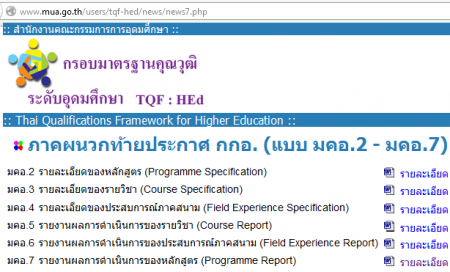
http://www.mua.go.th/users/tqf-hed/news/news7.php
คำอธิบายรายวิชา (Course Description)
คือ เนื้อหาสาระที่กำหนดเป็นหลักของแต่ละรายวิชาในหลักสูตร
ซึ่งถูกเขียนไว้ใน มคอ.2 ร่วมกับแผนที่แสดงการกระจายความรับผิดชอบ แล้วผู้สอนจะนำเนื้อหาไปเพิ่มรายละเอียดเป็นเค้าโครงการสอนใน มคอ.3 หรือ มคอ.4 เมื่อดำเนินการสอนแล้วเสร็จ ก็จะประเมินผลเป็น มคอ.5 หรือ มคอ.6 และ มคอ.7 ตามลำดับ
—
มคอ. คือ มาตรฐานคุณวุฒิระดับอุดมศึกษาแห่งชาติ
http://www.thaiall.com/tqf
http://www.mua.go.th/users/tqf-hed/news/news7.php
—
TECH 100 สื่อและเทคโนโลยีสารสนเทศ
(Media and Information Technology)
2(2-0-4)
ศึกษาความหมายและหลักการของเทคโนโลยีการสื่อสาร ความรู้เบื้องต้นทางเทคโนโลยีสารสนเทศ การประยุกต์ใช้เทคโนโลยีเพื่อการติดต่อสื่อสาร การศึกษาและนำไปใช้เชิงพาณิชย์ ประเภทของระบบสารสนเทศ การสืบค้นข้อมูล ระบบฐานข้อมูลเบื้องต้น ระบบสำนักงานอัตโนมัติ ความปลอดภัยและจริยธรรมในการใช้งานเทคโนโลยีสารสนเทศ
A study of communication technology meaning and principles, introduction of information technology, technology applications for communication, education and commercial application, types of information system, data retrieval, introduction to database systems, office automation system, security and ethics of information technology using.
—
BCOM 313 กฎหมายและจริยธรรมสำหรับผู้ประกอบวิชาชีพคอมพิวเตอร์
(Laws and Ethics for Computer Professionals)
3(3-0-6)
แนวคิดเกี่ยวกับคุณธรรมและจริยธรรม พระราชบัญญัติว่าด้วยการกระทําความผิดเกี่ยวกับคอมพิวเตอร์ กฎหมายทรัพย์สินทางปัญญา ลิขสิทธิ์ สิทธิบัตร เครื่องหมายการค้า กฎหมายว่าด้วยพาณิชย์อิเล็กทรอนิกส์ และกฎหมายที่เกี่ยวข้องความเป็นส่วนตัว อาชญากรรมผ่านสื่อทางคอมพิวเตอร์ กรณีศึกษาการใช้เครือข่ายสังคม
Concepts of morality and ethics, act on the offense on the computer, intellectual property law, copyright, patents, trademarks, law on electronic commerce and privacy laws, computer crime, case studies of social network.
—
CPSC 103 ตรรกะดิจิทัล
(Digital Logic)
3(3-0-6)
ระบบจำนวนและรหัสคอมพิวเตอร์ พีชคณิตบูลีน การวิเคราะห์และการสังเคราะห์ตรรกะคอมบิเนชันนัล ฟังก์ชันสวิทชิง รูปแบบคาโนนิคัล แผนที่คาร์นอฟ เทคนิคการลดรูป วงจรแนนและวงจรนอร์หลายระดับ และภัยในวงจร การวิเคราะห์และสังเคราะห์ตรรกะ ซีเควนเชียล การนำ
ฟลิปฟล็อปมาสร้างตรรกะ ตัวแปรสถานะ แผนภาพแสดง การเปลี่ยนสถานะ ตารางแสดงสถานะ การลดจำนวนสถานะ เทคนิคการกำหนดสถานะ และสภาวะการแข่งขัน
Number systems and computer codes, Boolean algebra, analysis and synthesis of combinational logic, switching function, canonical forms, Karnaugh map, minimization techniques, multilevel NAND and NOR circuits and hazards, analysis and synthesis of sequential logic, logic implementation with flip flop, state variables, state transition diagram, state table, minimization of states, state assignment techniques, and race conditions.
—
CPSC 205 ระบบปฏิบัติการ
(Operating Systems)
3(2–2–5)
สถาปัตยกรรม เป้าหมายและโครงสร้างของระบบปฏิบัติการ การจัดการการประมวลผล การกำหนดการการประมวลผล ความร่วมมือและการประสานเวลาของการประมวลผล สภาวะติดตาย สาเหตุ เงื่อนไข การป้องกัน การจัดการหน่วยความจำ หน่วยความจำกายภาพ หน่วยความจำเสมือน การจัดการหน่วยเก็บรอง จานบันทึก หน่วยเก็บขั้นสาม หน่วยรับเข้า/ส่งออก แฟ้มข้อมูล สารบบ ระบบปฏิบัติการแบบกระจายเบื้องต้น
Architecture, goals, and structure of operating system, process management, processes scheduling, process coordination and synchronization, deadlock, causes, conditions, prevention, memory management, physical memory, virtual memory, secondary storage management, disk, tertiary storage, Input/Output (I/O), file, directory, introduction to distributed operating systems.
—
CPSC 332 ปฏิสัมพันธ์ระหว่างมนุษย์กับคอมพิวเตอร์
(Human-Computer Interaction)
3(3-0-6)
พฤติกรรมมนุษย์ กระบวนวิธีการบันทึกและแปลพฤติกรรมมนุษย์ การวิเคราะห์ การทำงาน เทคนิคการสังเกต การออกแบบสอบถาม เทคนิคการวิเคราะห์และการโมเดลงาน วิธีแสดงส่วนปฏิสัมพันธ์และเครื่องมือสร้างต้นแบบ ขั้นตอนการเรียนรู้ การศึกษาการใช้งานและการวิเคราะห์โพรโทคอลการใช้คำ ปฏิสัมพันธ์ระหว่างมนุษย์กับคอมพิวเตอร์ แนวทางการทดลองทำจริง การเรียนรู้ของมนุษย์ การทำนายและการเลียนแบบปฏิสัมพันธ์ระหว่างมนุษย์กับมนุษย์และกรณีศึกษา
Human behavior, methodologies for obtaining and interpreting human behavior: work activity analysis, observation techniques, questionnaire, task analysis and modeling techniques, methods for interface representation and prototyping tools, cognitive walkthroughs, usability studies and verbal protocol analysis, the four approaches to human-computer interaction, empirical, cognitive, predictive, and anthropomorphic and case studies.
—
BCOM 241 โครงสร้างข้อมูลและขั้นตอนวิธี
(Data Structures and Algorithms)
3(2-2-5)
โครงสร้างข้อมูลแบบต่างๆ ลิสต์ สแตก แถวคอย ต้นไม้ กราฟ เซ็ต และ ฮีป การเรียงลำดับข้อมูลด้วยอัลกอริทึมแบบบับเบิล การแทรก เชลล์ ฮีป ควิก การค้นหาด้วยอัลกอริทึมแบบตามลำดับ แบบไบนารี ใช้ตารางแฮช โครงสร้างต้นไม้และการดำเนินการกับข้อมูลในโครงสร้างต้นไม้ โครงสร้างกราฟและการดำเนินการกับข้อมูลในโครงสร้างกราฟ การประยุกต์ใช้โครงสร้างข้อมูลเพื่อแก้ปัญหาในธุรกิจ ภาคปฏิบัติใช้โปรแกรมภาษาที่กำหนด เขียนโปรแกรมประยุกต์โครงสร้างข้อมูลและขั้นตอนวิธีเพื่อแก้ปัญหาในงานธุรกิจ
Type of Data structures, such as lists, stacks, queues, trees, graphs, sets and heap. Sorting algorithms, such as bubbles, insertions, shells, heaps, quicks. Searching algorithms, such as sequentials, binarys, hashing tables. Tree structures and operation of tree structures. Graph structures and operation of graph structures. Applying data structures, algorithms and writing programming for solve business problems.
—
CPSC 203 โครงสร้างข้อมูล
(Data Structures)
3(3-0-6)
ประเภทข้อมูลนามธรรมในภาษาชั้นสูง ประเภทข้อมูลแบบตัวชี้และเวกเตอร์ในภาษาชั้นสูง เวลาการรันงานและความซับซ้อน รายการโยง กองซ้อน แถวคอย การวนซ้ำและกรณีศึกษาด้านการคำนวณ ต้นไม้ กราฟ ฮีปทวิภาค ขั้นตอนวิธีของต้นไม้ กรณีศึกษาด้านการเรียงลำดับ ตารางแฮช การบีบอัดข้อมูล การจับคู่สตริง
Abstract data type in high level language, pointer and vector in high level language, running time and complexity, linked-lists, stacks, queues, trees, recursion, numerical case studies, trees, graph, binary heap, tree algorithms, sorting case studies, hash table, data compression, string matching.
—
BCOM 331 การออกแบบและพัฒนาเว็บไซต์
(Website Design and Development)
3(2–2–5)
โครงสร้างและการทำงานของเอกสารอิเล็กทรอนิกส์ทั้งแบบสแตติก และ ไดนามิก การออกแบบเว็บเพจ การจัดการเชื่อมต่อ การแทรกข้อความ เสียง ภาพนิ่งและภาพเคลื่อนไหว เทคนิคการเชื่อมโยงและการจัดการฐานข้อมูลบนเว็บไซต์ เน้นการฝึกหัด และการสร้างเสริมความเข้าใจในการปฏิบัติการเกี่ยวกับการออกแบบ และพัฒนาเว็บไซต์
The structure and operation of electronic documents as static and dynamic, web page design, manage connections, insert text, audio, still and moving images, linking techniques and database management on the website, focus on training and enhance the understanding of operating about design and website development.
—
CPSC 342 การออกแบบและพัฒนาเว็บไซต์
(Website Design and Development)
3(2-2-5)
โครงสร้างและการทำงานของเอกสารอิเล็กทรอนิกส์ทั้งแบบ Static และ Dynamic การออกแบบเว็บเพจ การจัดการเชื่อมต่อ การแทรกข้อความ เสียง ภาพนิ่งและภาพเคลื่อนไหว เทคนิคการเชื่อมโยงและการจัดการฐานข้อมูลบนเว็บไซต์ เน้นการฝึกหัด และการสร้างเสริมความเข้าใจในการปฏิบัติการเกี่ยวกับการออกแบบ และพัฒนาเว็บไซต์
Structure and operation of static and dynamic electronic documents. Webpage design, link management, insertion of text, sound, and animation. Link technique and database management on website. Practice to reinforce the understandings in the design and development of website.